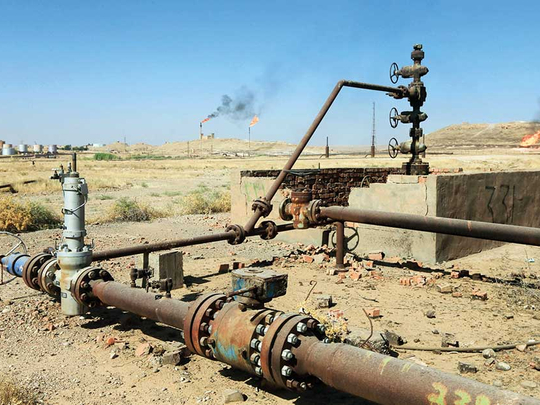
Tokyo: Oil dropped near $65 (Dh239) as the prospect of rising output in the US weighed on prices while investors continued to assess signs from Opec on whether it would ease production curbs.
Futures in New York fell 0.4 per cent after a 0.3 per cent drop Friday. The number of rigs drilling for crude in the US inched higher, signalling output may rise from record levels. Russia, which along with Saudi Arabia is trying to assemble support for lifting Opec and allies’ output limits, is said to have boosted crude production earlier this month to above the level envisioned by the group.
Oil has fallen to near the lowest level in two months after Saudi Arabia and Russia signalled they are ready to restore production in the second half of this year to offset potential supply disruptions in Iran and Venezuela. The latest sign of Russia’s willingness to relax caps is in contrast with some fellow producers including Iran, Venezuela and Iraq, which have signalled they are against restoring output ahead of the group’s key meeting in Vienna later this month.
“Investors are taking a wait-and-see stance until the Opec meeting,” Jun Inoue, a senior economist at Mizuho Research Institute Ltd., said by phone from Tokyo. Meanwhile, “growing production in the US is helping to create concerns of a surplus and will likely continue to weigh on West Texas Intermediate prices.”
Oil prices
WTI for July delivery fell 27 cents to $65.47 a barrel on the New York Mercantile Exchange at 4:03pm in Tokyo. Prices dropped 0.1 per cent last week, to cap a third weekly decline. Total volume traded was about 37 per cent below the 100-day average.
Brent futures for August settlement slumped 44 cents to $76.02 on the London-based ICE Futures Europe exchange. The contract dropped 0.4 per cent last week. The global benchmark traded at a $10.62 premium to WTI for August.
Futures dropped 0.2 per cent to 467.5 yuan per barrel on the Shanghai International Energy Exchange. The contract fell 1.4 per cent last week.
The US government has quietly asked Saudi Arabia and some other producers in the Organisation of Petroleum Exporting Countries to increase oil production by about 1 million barrels a day, according to people familiar with the matter.
Saudi Arabia and Russia, among countries that have the spare capacity to raise production, signalled last month they may restore output even though they hadn’t yet consulted most other producers about the proposal. Oil prices have fallen about 7 per cent since Saudi Arabia and Russia made their proposal public.
Output boost
Russia increased oil output to 11.1 million barrels a day during the first week of June, Interfax reported, citing an unidentified person familiar with production statistics. That’s above the 10.95 million barrels a day level envisioned by an agreement with Opec and allies, the report said.
“Opec will not bow and obey” to US pressure to increase oil production, said one of Iran’s representatives to the organisation. Iran and Venezuela — with little capacity to expand output — stand to suffer from such a move. Both nations also wrote to Opec members urging them to unite against American sanctions, while Iran also complained that some “fellow ministers” had tried to speak on behalf of the entire organisation, which is required to operate by consensus.
Meanwhile, Iraqi Oil Minister Jabbar Al Luaibi told Reuters last week a production increase is not on the table as the market is stable and prices are good.
In the US, drilling rigs targeting oil rose by 1 to 862 last week, the highest level since March 2015, according to Baker Hughes data, raising concerns over surging shale output which has been hitting fresh records this year.












